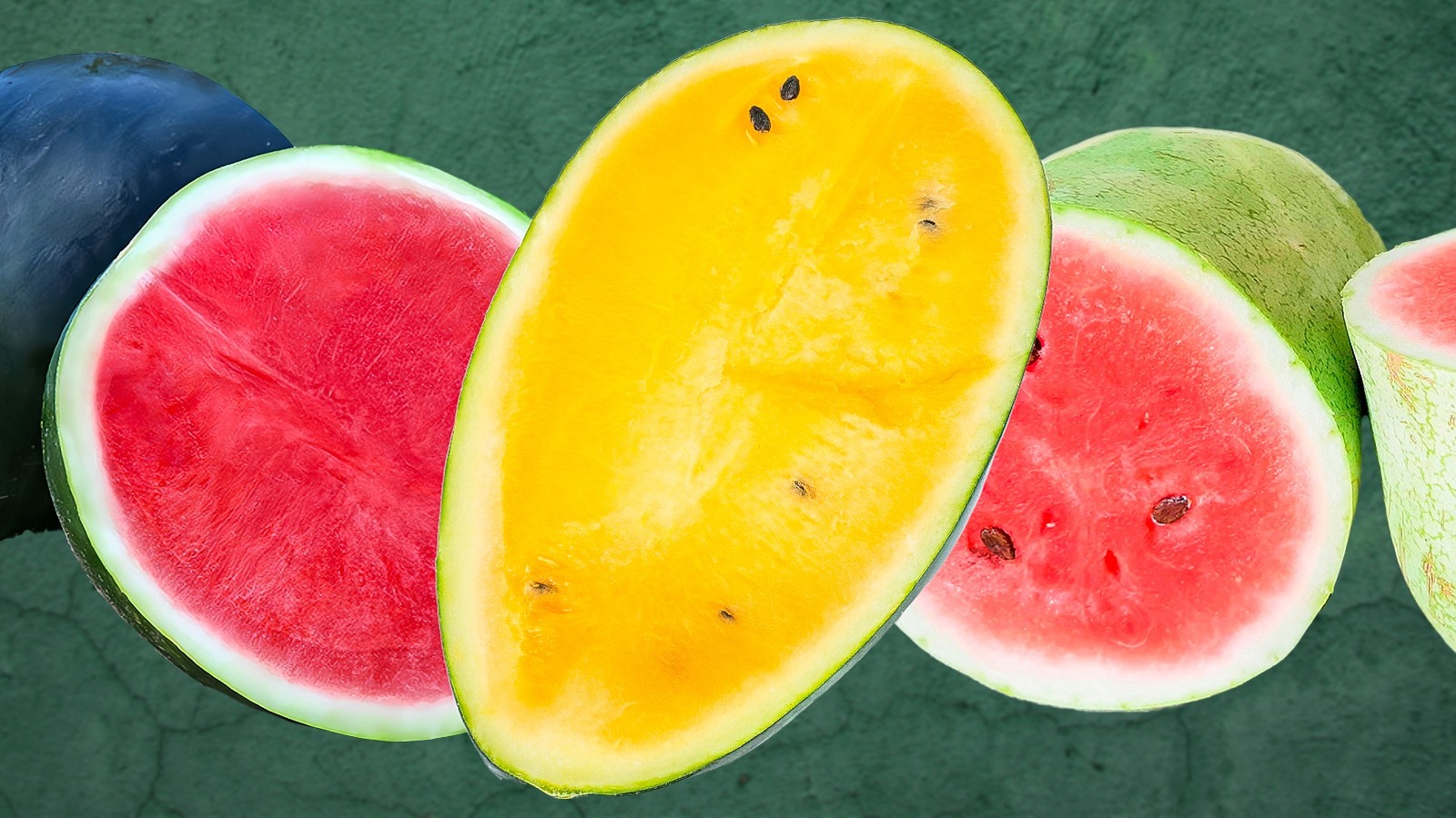We may receive a commission on purchases made from links.
Watermelon is one of the most refreshing fruits in summer, whether you consume it as a snack, paired with a feta salad, or transformed into a cruelty-free steak or even into a substitute for potato fries. While the specimens commonly displayed at grocery stores have a green rind, a reddish flesh, and black seeds, there are many other varieties, with different degrees of sweetness. Some have an oblong or a round shape, others sport a yellow exterior and flesh colors ranging from light pink to honey. But how do you pick the juiciest and sweetest of them?
This is where the official Brix rating comes along, determining not only a watermelon’s quality but also its pure sucrose content. The sweeter the fruit, the bigger its Brix value. A minimum level of 8 is required to signal a quality crop.
Watermelons, which have been cultivated as early as 2500 B.C. in Ancient Egypt, reached the Americas in the late 16th century. Today, there are about 300 varieties produced in the U.S. and Mexico alone, some more flavorful than others. A selection of the sweetest varieties of watermelon you can find should boast a Brix value of at least 11. Meanwhile, keep in mind that there are several tricks for picking out the tastiest watermelon at the store, from looking for a discoloration in the rind to checking for firmness and a dry, yellowish-brown stem.
Crimson Sweet
With its round-to-oval shape and alternating light and dark green stripes, Crimson Sweet is easily one of the most identifiable fruits in the produce section. Developed in 1963 by Kansas State University, it has, indeed, become the star of salads and picnics in warm weather.
With an average of 25 pounds, this rather large watermelon typically sports a tough rind and a crisp, juicy, deep red flesh dotted with a few dark seeds. Thanks to a Brix value that ranges from 11 to 12, it is noted for its delectable sweetness.
Nonetheless, that is not the Crimson Sweet’s only appealing feature. Farmers particularly enjoy cultivating it because it seems to be immune to aggressive fungal diseases, such as anthracnose and fusarium. Still, it does need its heavy dose of full sun in a sheltered, roomy space to reach full maturity (in about 80 to 90 days). Each plant yields three to five fruits, which are then usually harvested between June and September.
Mountain Sweet
Thanks to a Brix that ranges from 11 and 13, the Mountain Sweet is considered one of the most coveted and delicious types of watermelon. It’s also quite eye-catching, boasting an oblong shape, a dark green rind with light green stripes, and a firm, yellow flesh. There is a reason for this attractive golden pigment; it’s the complete absence of lycopene and the presence of both carotene and lutein.
You might think it a relatively new hybrid, but the tropical-looking Mountain Sweet was actually first produced in the mid-1800s by farmers in the Northeast, mainly in Pennsylvania, New York, and New Jersey. Though this fruit is easy to grow and reaches maturity in just 50 days, it still needs a regular regimen: Full sun exposure at least six hours a day, water about three times a week, and a soil that is moist but not too soggy are all required to grow Mountain Sweets. The use of organic pesticides also helps.
Charleston Gray
With a Brix value of about 13, the Charleston Gray is almost as sweet as honey and therefore irresistible. Two factors explain its designation. First, it was developed in 1954 by Charles Andrus, a famed watermelon producer in Charleston, South Carolina. Second, it is instantly identified by its tough, dull, greenish gray skin (which shields it from sunburn) and light green stripes. Once the rind of this oblong fruit is cracked open, you’re presented with a firm, fiber-free, bright red flesh.
Though it’s rather sensitive to frost, this fruit is impervious to bruising and the fusarium and anthracnose diseases. It can grow to 40 pounds and be harvested in 87 to 100 days, not to mention that it lasts a long time in your pantry. Here’s a tip for your fancy dinner party: pair the Charleston Gray with raw oysters to counter the latter’s overwhelming saltiness and add a colorful touch.
Densuke
If you’re looking to impress your employer or show your appreciation to someone special, then gifting them the world-famous and nearly seedless Densuke watermelon is your best bet. Or at least, that’s how the custom goes in Japan and other East Asian countries. Indeed, whether round or oval, this rare and precious crop is a visual feast, boasting a smooth and glossy dark skin and velvety, ruby red flesh.
Developed in the town of Toma, on the island of Hokkaido, the Densuke is a premium hybrid of several Japanese watermelon varieties. It can be grown in 85 days in a nutrient-rich, well-drained soil, under plenty of sunshine.
Unfortunately, this highly coveted type of watermelon, whose Brix can reach 12 and even 13, can cost a fortune. We’re talking hundreds and even thousands of dollars per piece, especially if an auction is involved; there was one that was sold for a whopping $6,100 in 2008.
Belmont
Bred by Sakata Homegrown, a division of Sakata Seed America, the Belmont is a small-sized, seedless (with some tiny white pips) type of Crimson Sweet watermelon that weighs between six and eight pounds. You’ll find it both tasty and handy, as it can easily fit in your fridge or cooler.
The Belmont’s skin is a shade of medium green with dark green stripes, while its deep red flesh is juicy, dense, and extremely firm to the touch. Boasting an average Brix of 12, this fruit can be harvested in about 90 days. It grows well in places like the East Coast and Brazil — though using a Sakata early pollinizer is essential for an optimal crop. It just needs plenty of sun and a loamy soil, i.e., a mix of clay, silt, and sand.
Hime Kansen
The Hime Kansen is an attractive watermelon, featuring vibrant green skin with dark green stripes, a very thin rind, and a firm, deep red flesh. It’s a convenient icebox-sized hybrid that weighs about six pounds and has a Brix measurement that ranges from 12.5 to 13.
Though it’s primarily cultivated in Japan, this seeded, somewhat oblong fruit tolerates heat extremely well and can also be grown in garden plots in places like Tampa, Florida. For it to reach full maturity in 95-100 days, though, it requires a lot of sun; a fine, sandy, well-drained, and fertile soil with a temperature above 50°F; and consistent watering.
For a deliciously refreshing and filling summer salad, consider tossing some chunks of Hime Kansen with feta or goat cheese, strawberries, romaine lettuce, dried dill, and bacon bits.
Orangeglo
First produced by the Willhite Seed Company in the early 1960s, the Orangeglo is an oblong watermelon with light and dark green stripes, a thin rind, and an average weight of 25 pounds. With a Brix value of about 11.6, it’s considered a high-quality sweet fruit.
True to its name, the Orangeglo offers a crisp, bright orange flesh with a few seeds and overflows with juicy goodness. You can consume it fresh as a snack; toss it in a salad with various citrus fruits, arugula, and feta; or blend it with lime juice, ice cubes, and sugar (or agave syrup) for an invigorating, vitamin-engorged frozen drink.
As far as planting is concerned, the Orangeglo is conveniently impervious to wilt and insects. It can grow in just about any region of the U.S., making it suitable even for novice gardeners.
Bradford
Boasting a Brix measurement of 12.5, the Bradford has an oblong shape, a thin, dark green rind striated with thin, darker vines, and a tender, bright red flesh. A fully grown crop has an average weight of 30 pounds.
Considered the sweetest watermelon variety in the South, the Bradford is an heirloom hybrid of the Lawson and the Mountain Sweet that was bred in 1840 by Nathaniel Napoleon Bradford of Sumter County, South Carolina. In the 1860s, it became a sought-after delicacy, so much that in later years, growers had to resort to placing electrocuting wires and sprinkling poison to ward off thieves.
Around 1922, this watermelon fell out of mass-cultivation because it didn’t fare well in storage and long-distance shipping, but it was eventually revived again by Bradford’s descendants. Today, this much-coveted sweet fruit is produced in limited quantity and has to be pre-ordered; priority is essentially given to chefs when it’s harvesting season.
Tropical Sunshine RZ F1
If there was ever an aesthetic, flashy, exotic-looking type of watermelon to decorate your table or add color and sweetness to your dishes, then the Tropical Sunshine RZ F1 is definitely it. The RZ in the name stands for Rijk Zwaan, a Dutch company that breeds over 1,800 types of premium fruits and vegetables and is present in 100 countries, including the U.S. As for the F1 hybrid designation, it signals a first filial generation type of seeds used by professional growers that yields a high-quality, uniform, and vigorous crop.
This roundish, seedless Sugar Baby type of watermelon carries a dark, glossy, and tiger-striped skin, a luscious, vibrant yellow flesh, and a whopping Brix value of 13. The crop typically matures in 78-80 days, weighing between 12 and 15 pounds in average.
Cracker Jack F1
The Cracker Jack F1 is another premium and extremely popular type of watermelon that yields consistent crops, and its high sweet content has awarded it a Brix value of about 12.25. This blocky and oval hybrid fruit sports a dark green rind with light green stripes; a firm, seedless, very dark red flesh; and small white pips. It reaches relative maturity in 82 or 84 days, weighing between 15 and 18 pounds in average.
Plus, good news for growers: The Cracker Jack F1 seems to be relatively resistant to many diseases, such as anthracnose and fusarium wilt. It just needs southern exposure and a finely textured, well-drained soil. Keep in mind, however, that overwatering the crop in its last stage may reduce its sweetness and flavor and should therefore be avoided.





